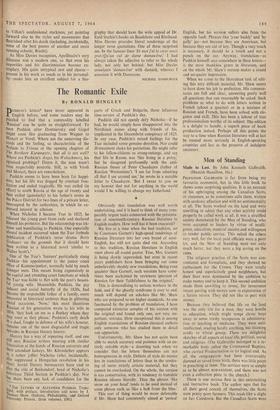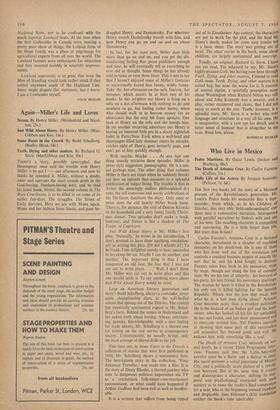Men of Standing
Made to Last. By John Kenneth Galbraith. (Hamish Hamilton, 16s.) PROFESSOR GALBRAITH is far from being my favourite economist, but in this little book he shows some surprising qualities. It is an account of his upbringing among the Canadian Scots, or clansmen, as he sometimes calls them, written with sardonic affection and with no sentimentality at all. The Scots worked on the land and were unwilling to admit that any other activity could properly be called work at all. It was a stratified society dominated by the Men of Standing, who were accepted as leaders by virtue of intelli- gence, education, material success and willingness to render public service. This suited the others very well, for the local paid officials were a poor lot, and the Men of Standing were not only much better, but they were a big saving on the rates.
The religious practice of the Scots was con- ventional and formalistic, and they showed no enthusiasm for the Crown. They were totally honest and superlatively good neighbours, but their lives were dominated by the ambition to make money and to keep it. This second ambition made them unwilling to invest, for investment meant parting with money now in expectation of a future return. They did not like to part with money.
Because they believed that life on the land was the only life for a man, they were hostile to education, which might tempt clever boys away to some trashy occupation in administra- tion or teaching or medicine. They were anti- intellectual, reading hardly anything, but listening avidly to trivial gossip. There are delightful sketches of all aspects of local life, political, social and religious. (The Galbraiths belonged to a re- markable body called the Covenanted Baptists, who carried Predestination to its logical end. As all the congregation had been irretrievably damned or saved from birth, there was little point in preaching at them. The services were so simple as to be almost non-existent, and there was not even a collection plate in the church.) There is one serious flaw in this entertaining and instructive book. The author says that for all their good conceit of themselves, the Scots were pretty poor farmers. This reads like a slight on fair Caledonia. But the Canadian Scots were Highland Scots, not to be confused with the much superior Lowland Scots. At the time when the first Galbraitbs in Canada were making a pretty poor show of things, the Lothian farm of the Hope family was a place of pilgrimage for agricultural experts from all over the world. The Lowland farmers were enthusiastic for education and they invested lavishly in scientific improve- ments.
Lowland superiority is so great that even the Men of Standing would look rather small if they settled anywhere south of the Highland Line. Some might dispute this statement, but I know. I am a Lowlander myself.
COLM BROGAN































 Previous page
Previous page